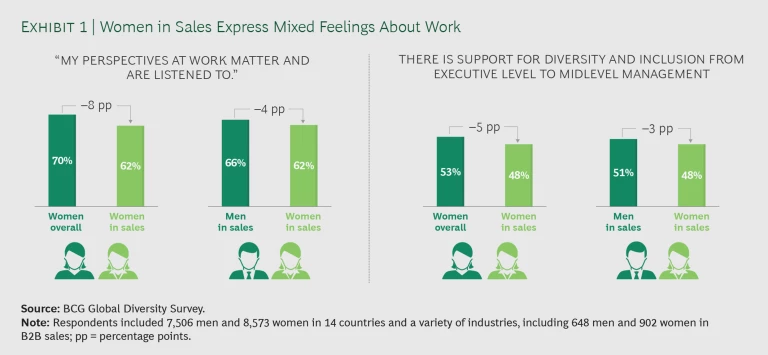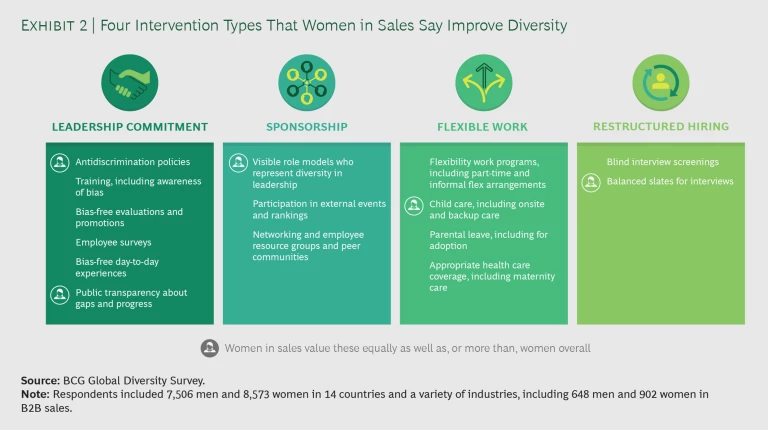Sales leadership has a gender gap problem. Even though women meet their sales quotas as well as or better than men, there’s a dearth of women in top sales roles. Indeed, there are fewer women leaders in sales than in any other business function except supply chain and logistics. If organizations want to improve overall financial results, then they’ll need to do a better job of attracting, retaining, and promoting women in sales.
But rethinking hiring alone won’t be enough to fix the problem. To give women the boost they need to make it to the top, organizations must change how work gets done and encourage sponsors to help guide the careers of women in sales. Companies also need to publicize the actions they’re taking to improve equity. Our research shows that women in sales are more likely than their male colleagues to appreciate transparency about gender gaps and the steps that their organization is taking to address them.
Organizations must change how work gets done and encourage sponsors to help guide the careers of women.
What’s Keeping Women from Advancing into Leadership Roles in Sales?
Many reasons account for the low representation of women in sales leadership roles. For one, sales jobs haven’t always been viewed as positions in which women could excel, and fewer women proactively seek them out as a result. “I was convinced sales was something for men, where you have to be aggressive and always be closing,” said one woman we interviewed who switched to sales from a customer service role after being encouraged by a sales leader.
Our research indicates that women who pursue careers in sales don’t feel sufficiently valued or supported at work. That finding comes from a recent BCG global diversity report , which surveyed 7,506 men and 8,573 women in 14 countries and a variety of industries, including 648 men and 902 women in B2B sales. Specifically, fewer women in sales than either women overall or men in sales say that their perspectives at work matter or are listened to or that they have the support of executive level or midlevel management. (See Exhibit 1.) Such an inclusion gap can often lead to a gap in ambition as well.
According to our research, women in sales see less commitment to the advancement of women within their function than their peers in other departments do. They are less likely than women overall or men in sales to say that their companies are doing a lot to improve diversity and inclusion; that their companies’ progress toward improving diversity and inclusion has improved during the past three years; or that their management has good diversity in the top team. Women in sales also are less likely than other groups to report that the men in their company are involved in championing gender diversity. All of these factors can make women less likely to remain engaged in their jobs .
That has to change. B2B selling is a relationship business. To boost revenue, organizations need to make sure that existing customers are happy—so they will buy more, buy again, and recommend the business to others. That applies whether a company sells ERP systems or factory automation tools. Building solid sales relationships requires salespeople who can listen and solve problems. Many of those skills are commonly associated with women.
What Organizations Must Do to Change
Sales organizations and individual sales leaders must take deliberate actions to hire and retain the best talent. If they don’t, they risk losing some of their best performers. Our research finds that despite their successes, women in sales are more likely than women overall and men in sales to say they expect to look for a new job in the next three years. “I believe in longevity and loyalty and my company becoming like my family,” said one woman in sales we interviewed as part of our investigation. “When I don’t feel that’s being reciprocated or don’t feel like they’re looking out for me, that’s where they’ve lost me.”
This sentiment is reflected in previous BCG research on gender-based ambition gaps . Women and men start their careers with the same level of ambition, and both genders become less ambitious as they age. But at organizations where employees report less diversity, the drop-off in ambition is faster for women: from ages 30 to 40, a time that is pivotal in their careers, women’s ambition trails men’s by 17%.
Organizations must also improve the performance of existing staff and take advantage of women’s innate potential.
All these efforts can be boiled down to four key areas: leadership commitment, sponsorship, flexible work, and restructured hiring. (See Exhibit 2.)
Leadership Commitment. Our research shows that women in sales value an organization’s ability to be transparent about gaps in gender diversity and any progress made in filling those gaps. Companies that have already acted to rectify the gender imbalance in sales leadership can use that improvement to their advantage by making data about the progress of diversity and inclusion initiatives visible to all employees.
Any company setting diversity and inclusion goals should make changes in daily behavior part of those goals, including:
- Showcasing role models to demonstrate the behaviors and culture that people should aspire to. “The more women we see in the more senior roles, the more confidence it would give women to do their best,” said one woman we interviewed who works in cybersecurity sales.
- Tracking gaps in retention and advancement to uncover the factors that either helped people advance in the past or, conversely, caused them to leave.
- Calling out inappropriate behavior, such as other people speaking over women in meetings.
In addition, sales leaders should be held accountable for taking steps toward desired diversity and inclusion goals.
Sponsorship. The women we talked with as part of our research described feeling like they had to work twice as hard as their male counterparts in order to prove themselves. Having a vocal, supportive sponsor can build up women’s confidence and inspire them to pursue leadership roles. In the context of career development, a sponsor is someone who acts as an individual’s career navigator, helping them map out a path to increasingly more senior roles, introducing them to people who could help their careers, and being a vocal advocate for them within the organization.
For example, a manager could act as a sponsor to a new sales rep by introducing her to the customers in their territory. “At my prior company, I had a good relationship with the CEO,” said one woman in sales we interviewed. “Every time, he’d introduce me as some sort of a rock star, and it went a long way in boosting my confidence.”
Flexible Work. Sales might not be the first thing that comes to mind when you think of flexible work, but many sales jobs are inherently flexible. Salespeople don’t always work 9 to 5. Many routinely toggle between engaging with clients—including traveling to see them in person—and performing other tasks. They also are more likely to be paid on the basis of performance rather than on time spent in the office, a compensation model that lends itself to flexibility.
To support and promote everyone, including women, companies should formalize and encourage the flexibility that sales roles are inherently well positioned to offer. Although following traditional models of part-time work may not be possible, flexible work can be introduced in other ways. People could work on a smaller territory, for example, or partner with others to cover accounts, thus lowering quotas.
Restructured Hiring. Moving more women into sales leadership roles entails transforming recruiting practices to overcome managers’ inherent bias of hiring people who look like them. It also involves rethinking the promotions proces sales organizations can use data analytics to understand the skills that are correlated with success and then design recruiting and promotions programs to identify people with those skills. To ensure that all candidates for open jobs or promotions have a fair shot, companies can adopt practices—such as using blind screenings and conducting structured interviews—to eliminate bias from processes.
Moving more women into sales leadership roles entails transforming recruiting practices and rethinking the promotions process.
Sales organizations can also expand the candidate pool that they normally draw from in order to find people with the right skills. As one sales leader told us, “Don’t let the recruiting pool define your organization.”
Recruiting doesn’t automatically mean looking externally for new hires. Companies can evaluate current employees in departments other than sales who might show promise because of their relationship-building and listening skills. Another promising, though often forgotten, talent pool comprises former employees or other colleagues (usually women) who have taken a career break .
Things to Think About
Creating a culture to help women in sales thrive and advance in their careers isn’t easy, and organizations that endeavor to make changes in order to support them should be prepared for setbacks along the way. However, their chances for success are greater if they adhere to the following:
- Be patient. Changing the status quo isn’t easy. Set an ambition and hold people accountable, but don’t expect transformation to happen overnight.
- Understand your talent flow. Study your workforce to determine at what stage of life sales personnel are likeliest to leave—because they might not be getting the sponsorship, support, or acknowledgement they need—and then develop a strategy to address these challenges.
- Listen to your organization. Ask employees and management within the organization what they see as the friction points within this issue and then make sure that the changes you make address them.
- Involve the entire organization. A culture change such as the one outlined here will fail if it’s seen as yet another top-down diversity initiative. To gain broad buy-in, build a business case for any actions you take—and make sure the actions are the right ones.
Sales organizations that don’t actively promote women into leadership roles aren’t doing a disservice to just those employees. Because women meet sales quotas as well as or better than men, organizations that don’t promote them into positions of leadership run the risk of underperforming, which could directly affect their bottom lines. Small tweaks alone aren’t enough to close this gender gap. To effect lasting change, companies must take a new, out-of-the-box approach that rethinks how work is divided and how people are supported—and is equitable for all.











